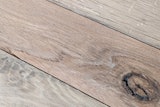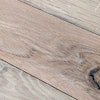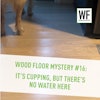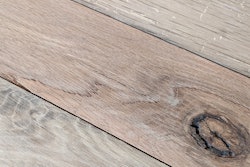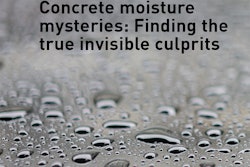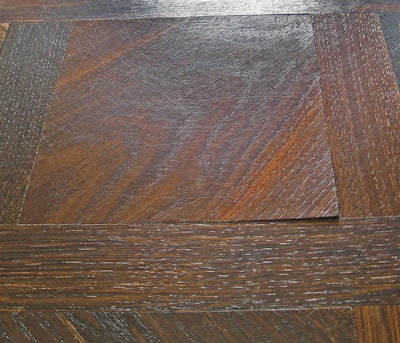

The Problem
Several hundred square meters of a premium-quality, custom-designed engineered parquet floor suffered severe curling of the corners during the first heating season after installation.
The Procedure
The floor was three-layer parquet with a 7-mm-thick, smoked-oak top layer with the grain direction diagonal to the panel edges. Each panel had an 8.5-mm-deep groove on all four sides and was connected to the surrounding frame by a loose tongue. It was bonded to a heated slab.
The Cause
The site visit took place in summer. During the inspection, the curled corners were observed only on the flat-grained top layers, and only corners on the diagonal perpendicular to the grain were affected. At the raised corners, the panel core had split at the groove base.
No drying-induced damage such as excessively wide joints or conspicuous checks was encountered. The absence of checks in the parquet and of drying-related failures on the other wood assemblies in the building suggested that extreme overdrying was improbable. The moisture content of the top layer at the time of manufacture was estimated by cutting it away from the panel core, and the sizes of the cut-free layers indicated the top layer did not have an excessively high moisture content at the crucial time of bonding to the panel core.
The only conspicuous feature was the unusual grain direction of the top layer.
At first sight, the design of the parquet flooring in no way appeared out of the ordinary. The only conspicuous feature was the unusual grain direction of the top layer, whereby the diagonal between two of the corners was perpendicular to the grain. A series of tests with similar parquet revealed the implications of this grain orientation:
• Panels with the grain parallel to the panel edges showed no or very little splitting, even under extreme dry conditions.
• With diagonal grain samples, the sensitivity to drying strongly increased with increasing depths of the groove, but with a rounded groove base, no splitting occurred.
The unnecessarily deep (8.5 mm) and rectangular groove with loose tongues significantly increased the sensitivity of this parquet to dry environmental conditions. The overlooked consequence of the diagonal grain direction was a concentration of all shrinkage stresses precisely at the upper edge of the angle in the groove base, i.e., theoretically at a single point. The reduction of the groove depth, the provision of rounded groove base or even two drops of adhesive on the loose tongue at the corner would have spread these stresses more uniformly and protected the parquet floor against splitting.
How to Fix the Floor
It might have been possible to drill small holes and glue down the corners with an injected epoxy resin; the tongue would stabilize the critical corners of the parquet. On the other hand, this procedure would have caused minor visual disturbances. Due to the requirement of a perfect visual appearance of the floor, this possibility was rejected and the floor was removed completely.
In the Future
Possible stress concentrations should be taken into account when unusual designs are planned, and grooves should be as shallow as possible to avoid high stresses.
This information is from the author's book "Failure Analysis of Wood and Wood-Based Products." A longer version of the above article excerpted directly from the book follows:
Diagonal Grain Orientation as Cause of Parquet Failure
A premium-quality, custom-designed parquet floor suffered severe damage over an area of several hundred square meters during the first heating season after installation. Some of the corners of the square panels had curled up by several millimeters. The floor was three-layer parquet with a 7-mm-thick, smoked-oak top layer. It was bonded to a heated slab, and the surface was oiled.
 Figure 1: Three-layer parquet with smoked-oak top layer, bonded to a heated screed and with oiled surface. The grain is diagonal to the panel edges. The direction of maximum swelling and shrinkage, which is perpendicular to this, thus runs exactly between two of the corners. The site visit took place in summer. The users reported that the corner curling was much more pronounced in the heating season.
Figure 1: Three-layer parquet with smoked-oak top layer, bonded to a heated screed and with oiled surface. The grain is diagonal to the panel edges. The direction of maximum swelling and shrinkage, which is perpendicular to this, thus runs exactly between two of the corners. The site visit took place in summer. The users reported that the corner curling was much more pronounced in the heating season.
During the on-site inspection, the curled corners were only observed on flat-grained top layers. Moreover, given that only corners on the diagonal perpendicular to the grain were affected, it was fair to assume that shrinkage of the top layer was a causal factor. Nonetheless, no other moisture-induced damage, e.g., in the form of excessively wide joints or conspicuous checks, was encountered.
With all panel specimens taken during the site visit, the same failure pattern was found at the raised corners: here, the panel core had split at the groove base.
 Figure 2: The curling at the panel corners had induced a split in the core, which originated at the angle in the groove base.
Figure 2: The curling at the panel corners had induced a split in the core, which originated at the angle in the groove base.
All the findings suggested that the top layer had shrunk during service and that the resulting stresses had led to the split in the core.
The following scenarios (and, of course, combinations thereof) were thought to provide a satisfactory explanation of the observed phenomenon:
1. An excessively high floor heating temperature had caused over-drying of the parquet, such that failures were inevitable.
2. The moisture content of the top layer was much too high when the parquet floor was laid.
3. The parquet flooring was subject to design flaws or material-related weaknesses.
No measurements were available to establish the moisture content of the parquet during service. According to the users, the specified maximum temperature of the floor heating system was never exceeded. The parquet manufacturer, on the other hand, claimed that the allowable temperature had been substantially exceeded even during commissioning of the heating installation. A strong argument against any severe over-drying of the top layers during service was the absence of the surface checking typically associated with this. With flat-grained lumber, at least fine checks would have been expected. It was nonetheless unfeasible to reconstruct the previous environmental conditions. The absence of checks in the parquet and of drying-related failures on the other wood assemblies in the building did, however, suggest that extreme over-drying was improbable.
The moisture content of the top layer at the time of manufacture was estimated by cutting this away from the panel core: the sizes of the cut-free layers were found to be roughly identical when measured under standard environmental conditions of 20°C/50% relative humidity (RH). This indicates that the top layer did not have an excessively high moisture content at the crucial time of bonding to the panel core.
At first sight, the design of the parquet flooring in no way appeared out of the ordinary. Each panel had a 8.5-mm-deep groove on all four sides and was connected to the surrounding frame by a loose tongue. The only conspicuous feature was the unusual grain direction of the top layer, whereby the diagonal between two of the corners was perpendicular to the grain. With this arrangement, the loads acting on the grooves at these corners evidently differ from standard designs, where the grain runs parallel to the panel edges. In the latter case, the stresses acting on the grooves during shrinkage are uniformly distributed over the entire panel length. In the investigated case, however, these stresses were concentrated at a single point in the groove. This was the exact position where the splits occurred. A series of tests were performed to determine the implications of the diagonal grain orientation.
Similar parquet panels measuring 90 by 90 mm with different grain directions and groove sizes/shapes were bonded to tiles and exposed to various environmental conditions (20°C/22% RH, 20°C/15% RH, and 40°C/11% RH). The installed floor heating system and reduced humidity directly over the warm parquet surface mean that at least the 22% RH and 15% RH test conditions are not unrealistic.
 Figure 3: Top views and cross-sections showing grain directions and groove geometries (0-mm, 4-mm and 8-mm rectangular groove, 9-mm groove with rounded base) of tested specimens. The tiles to which the specimens were bonded prior to the environmental tests can be seen on the left-hand side of each cross-section.
Figure 3: Top views and cross-sections showing grain directions and groove geometries (0-mm, 4-mm and 8-mm rectangular groove, 9-mm groove with rounded base) of tested specimens. The tiles to which the specimens were bonded prior to the environmental tests can be seen on the left-hand side of each cross-section.
Storage of the specimens under different environmental conditions clearly revealed the significance of the various parameters with regard to splits in the core (Figure 4).
• The specimens with grain running parallel to the panel edges suffered no splitting at 15% RH, even with a 8-mm-deep groove.
• The specimens with diagonal grain orientation suffered a greater number of splits as the groove depth increased. With an 8-mm-deep groove, splits were observed at five angles in the groove base after storage at 15% RH.
• The specimens with diagonal grain direction and a rounded, 9-mm-deep groove suffered no splitting, even at 11% RH.
 Figure 4: Number of splits in groove base after two of the three environmental tests. None of the specimens suffered damage at 20°C/22% RH.
Figure 4: Number of splits in groove base after two of the three environmental tests. None of the specimens suffered damage at 20°C/22% RH.
The conclusion drawn from these tests is that the unnecessarily deep (8.5 mm) and rectangular groove with loose tongues significantly increased the sensitivity of this parquet to dry environmental conditions. The overlooked consequence of the diagonal grain direction was a concentration of all shrinkage stresses precisely at the upper edge of the angle in the groove base, i.e., theoretically at a single point (Figure 5). The simple provision of a rounded groove base, a reduction of the groove depth or even two drops of adhesive on the loose tongue at the corner would have spread these stresses more uniformly and protected the parquet floor against splitting.
 Figure 5: The diagonal grain direction of the oak created stress peaks at the angles in the groove base. Stress calculations for the parquet construction (right) confirmed the stress peaks caused by the shrinkage of the top layer.
Figure 5: The diagonal grain direction of the oak created stress peaks at the angles in the groove base. Stress calculations for the parquet construction (right) confirmed the stress peaks caused by the shrinkage of the top layer.
I always view this case with a good deal of humility. Had the parquet contractor sent me the construction drawings for checking prior to installation, I would probably not have recognized the problems that now appear so obvious. Failure investigators are always in a privileged situation in that they only step in after failures have occurred, their only job being to hunt down the cause. In doing so, they often gain insights that are unavailable to the contractors entrusted with realizing innovative designs.










